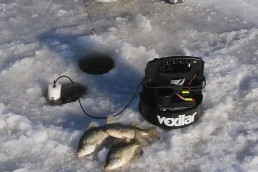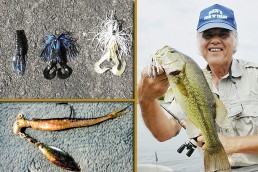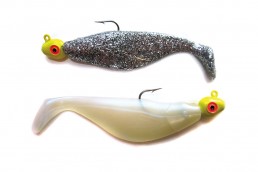Swinging Jigs add Life
SHARE THIS POST
In fishing if someone says to “swing it” they aren’t talking about picking up the tempo of the music or hitting a home run. Instead, they are talking about using a swinging jig head to make their soft plastic lure take on new life. This style of jig is a very simple head that allows the hook to be free, which permits the bait to float upward and have a life-like freedom of movement.
Swinging jigs come in round and football head models, most of which are heavy in weight and have one style of larger hook. The model that I used is called a Dragon Hopper, made by Mad Bug Lures. These are of the football variety—available in smaller weights of 3/8 ounce and smaller—and have smaller hook sizes in the Xgap and sprout worm hook variety. The smaller hooks and weight sizes are perfect for my type of finesse fishing, which goes hand-in-hand with the Blitz Spyder Finesse Jig.
I’ve found these to work well in fishing almost any type of fish holder. Surprisingly, it worked fairly well when fishing heavy coontail weed, without having a lot of serious hang-ups. In fact, many times it would produce strikes when popped loose from the weeds. If there was moss, then it was a different story, as it is with about any lure fished in the “slop.”
With any fishing, I always try going with the lightest weight that will work, so that it falls slowly to give the fish a longer time to take a good look, and it is no different with this jig head. That holds especially true when fishing the aforementioned weeds, which I prefer to use the 1/8 ounce, but will go to the 1/4 ounce, all of which depends on how easily the jig is moving over the weeds, or how the wind and/or current is dictating the need for a heavier weight.
The hook style and size should be matched to the bait, as with any Texas-rigging situation. I use the Xgap style for tubes and thicker bodied baits like the Power Chigger Craw and Havoc Pit Boss, and the sprout worm style for any of the plastic worms. In size selection I normally go no larger than 3/0 or 4/0 in the Xgap style and 2/0 and 3/0 in the sprout style.
While on the subject of hooks, Ron Risenhoover, president of Mad Bug Lures/Kick’N Bass Attractants, passed along a vital tip during a conversation.
“One ‘trick’ I have found is that the Dragon Hopper and those swing-style heads, are very, very, very unforgiving about losing fish,” Ron said. “We have found, if you will bend the hook point out slightly it will help increase the hook to catch ratio. Also, you only get one jump before you are on borrowed time and the fish throws it. So, keep the rod tip down and reel hard to keep the fish from jumping and you can get it in. Many of the local guys quit using them because they kept losing the fish. We never did tell them the secret.”
Well, sorry Ron, but we may have just let out your secret.
Four basic retrieves work for this jig: lift-and-fall, hop, swim and drag/crawl.
The lift-and-fall is what this jig is all about. The design is to have the bait float upward. With all the retrieves, pay close attention to the line as the jig is falling, since many times this is when the strike comes—on the fall, or as it hits the bottom. With this retrieve it is constantly on the fall and hitting the bottom. It is simple, in lifting the rod tip whatever distance may be needed from the bottom, and then letting it fall back. A worm like the Stanley Sidewinder or B-Fish-N Ringworm is a perfect choice.
Are you enjoying this post?
You can be among the first to get the latest info on where to go, what to use and how to use it!
Hopping the jig is a favorite retrieve to use along weed edges and rocky or riprap shorelines. Very the hopping rhythm between quick pauses to let the jig stay in contact with the bottom. For example, hop it “3 short hops, pause, and then 3 short hops,” working it this way all the way back. To vary the retrieve, change the number even to the point of making it different between hops, such as “3-2-3-2” and so on. With this retrieve I like to use baits like the Power Chigger Craw and Havoc Pit Boss—normally I prefer the Pit Boss Jr. with no larger than a 1/4-ounce head when fishing weeds.

The aforementioned weeds are usually best fished with the swimming retrieve. It is simple enough. Just swim the jig along with a pump or straight retrieve, allowing it to free fall every now and then in gaps, and over weed edges. Again, the plastic will float upward on the fall, and with any tail action this will double the possibilities of a strike. When swimming it over and through the weeds, there are occasional hang-ups, which can be popped loose with a quick jerk, again with a high possibility of a strike occurring shortly afterward, especially if there is open water on the outside of where it was popped loose. For this retrieve, I prefer something with good tail action like a Power Ribbon Tail, Mann’s Augertail or B-Fish-N Kgrub, but I will also use the Pit Boss Jr., which has a kicking action.
Flipping/pitching and working other wood and rock cover is a very good time for dragging/crawling the jig. Work it slowly over and through the cover, letting it fall over anything that it may crawl over, such as a limb or stump. This is the perfect retrieve to combine with a lift-and-fall when flipping stumps and working the root system, which should be worked well out from the stump in areas where they have been uncovered. Use baits previously menitoned for this retrieve, since in a way flipping/pitching is a combination of the other retrieves, only in a closer area since these are not long casts.
Ron mentioned something else interesting during our conversation.
“This jig has the uncanny ability to catch larger than normal fish.”
Perhaps he is correct, as I’ve been having a very good average size catch.
With the development of the Dragon Hopper, I can now grab a handful in my favorite weights (1/8- and 1/4-ounce weights) and hook sizes in 3 colors (White, Black/Blue, Crawfish) of the Blitz Spyder Finesse Jigs, Road Runners in 3 sizes (1/16-, 1/8- and 1/4-ounce weights), 3 colors (Chartreuse/Black back, Diamond Dust and Apricot) of Rat-L-Traps and my favorite soft plastics to be used with all the jigs and I’m ready to go fishing. All of this, plus a few other items, can easily fit in one 4870 Plano Tackle Bag.
The next time you want to experiment with something new to “stir” the fish into striking, try “swinging it.”
If you have any further questions about this or any other fishing subject, drop me a line through the Dan’s Fish ‘N’ Tales® website at dansfishntales.com, or Facebook page at facebook.com/dansfishntales.
MWO
SHARE THIS POST
Did you enjoy this post?
You can be among the first to get the latest info on where to go, what to use and how to use it!
Dan Galusha
Dan Galusha has fished all of his life, worked more than 45 years in the outdoor/media industry, and was inducted into the Fresh Water Fishing Hall of Fame as a Legendary Communicator. Direct questions through dansfishntales.com, facebook.com/dansfishntales and facebook.com/shootnplink.



